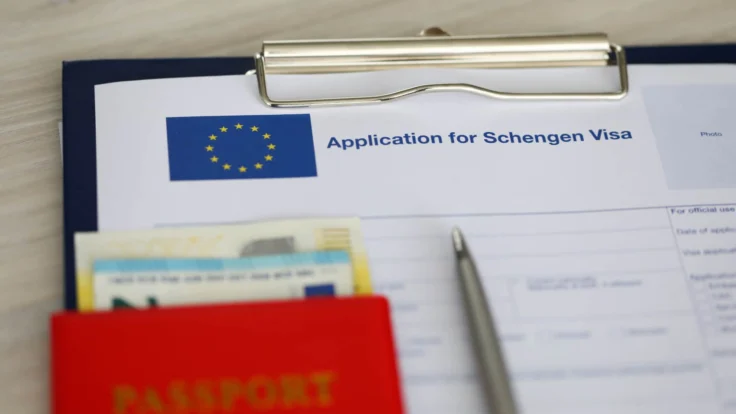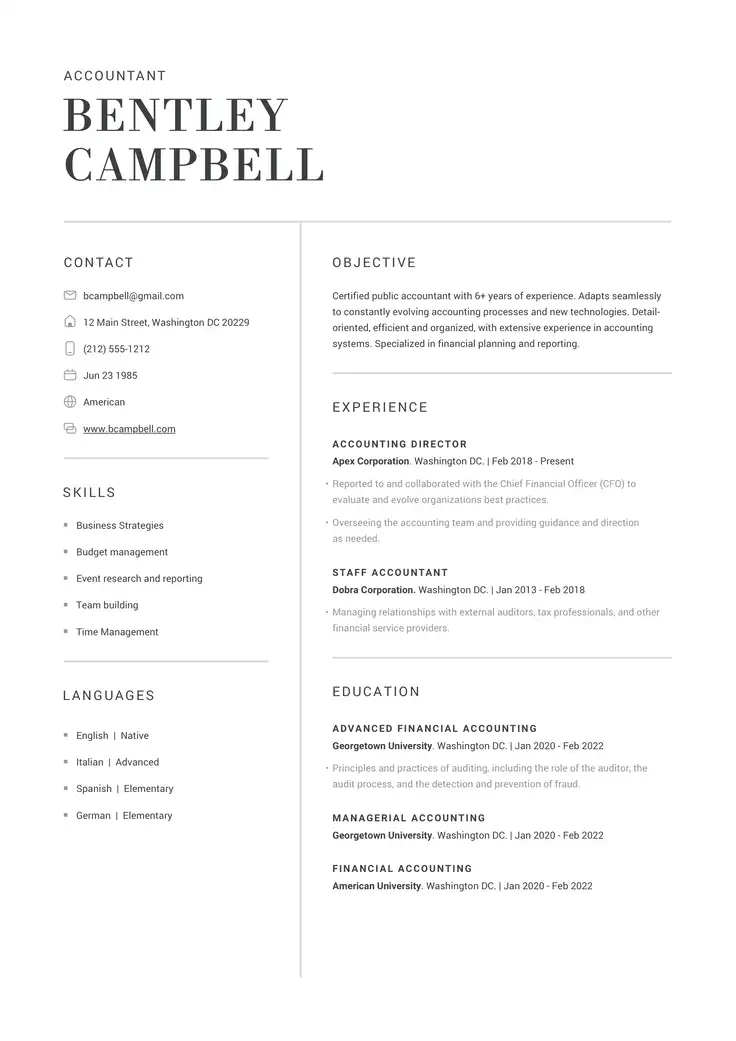If you’re looking to apply for jobs in Europe, you may be wondering if the process is any different from that in the United States or other regions. While they have some things in common, some companies and institutions require a specific type of resume. Or as it’s called in Europe, a CV or curriculum vitae.
Though there are numerous types of resume formats you can use in Europe, the Europass, also known as the “European resume”, was developed by the European Commission in the 1990s as a standardized format.
It has a user-friendly structure and is accepted throughout Europe, (except in the UK).
Keep reading to find out what a Europass CV entails and how to write one.
What Is the Europass Resume for Europe?
The Europass CV aims to simplify the job application process for candidates from diverse linguistic backgrounds who want to apply for jobs in Europe.It is a resume format that can be easily understood by European employers throughout the continent.
The great news is that it’s not exclusive to Europeans.
Americans can also use the Europass to create their own European CV to properly demonstrate their qualifications to employers in Spain, Germany, and just about any country in Europe.
In the following sections, you’ll learn how to format and write your own Europass CV with the help of examples and actionable advice.
Europass CV format
The Europass is a resume format with a specific structure that makes it simple for employers to compare candidates.
It has 5 basic sections:
- Personal information
- Work experience
- Education and training
- Personal skills and competencies
- Additional information
As you see, this European-style resume offers a straightforward approach to presenting your qualifications and work experience and is similar to a U.S-style resume.
How to write a Europass CV
With its 5 sections and simple design, writing a Europass CV is very easy.
To create yours, follow the steps below:
- Use a template: Start with our online resume builder by selecting the European Format. It provides a clear structure to follow and ensures you configure your resume correctly.
- Fill in your personal information: Include your name, date of birth, and contact details.
- List your work experience, education, and training: Mention your most recent experience first, followed by the previous ones. If you have gaps in your work or education history, provide an explanation for them.
- Highlight other qualifications: Include any relevant courses, certificates, or diplomas.
- Add any additional information: List your language skills, volunteering experience, or any other relevant details.
- Proofread your resume: Check for any spelling or grammatical errors before submitting it. Ask a friend or colleague to review your resume and provide feedback.
Example of a Europass CV
Below, you’ll find a European resume example that follows the standardized Europass format. This sample can serve as a helpful guide when creating your own.
Samantha Johnson
123 Main Street, New York, NY 10001
555-555-5555
samantha.johnson@example.com
WORK HISTORY
Laboratory Assistant, 04/2019 – Current
ABC Research Institute – New York City, NY
- Conducted over 200 laboratory tests and experiments following established protocols and procedures under the supervision of senior researchers.
- Maintained and calibrated laboratory equipment, resulting in a 30% decrease in equipment malfunctions and increased efficiency in experimental procedures.
Laboratory Assistant, 07/2014 – 04/2019
XYZ Pharmaceuticals – Boston, MA
- Prepared over 500 laboratory samples for experiments, resulting in the successful completion of numerous research projects and product development initiatives.
- Conducted quality control checks on laboratory samples, leading to a 20% increase in accuracy and reliability of experimental results.
EDUCATION
Bachelor of Science in Chemistry, 2011
New York University – New York City, NY
SKILLS
- Mother tongue – English
- Languages – French C2
- Interpersonal – Collaborated with laboratory teams of 5+
- Organizational – Maintained meticulous records and documentation of laboratory procedures, inventory, and experimental data.
- Job-specific – Demonstrated proficiency in operating and maintaining laboratory equipment, such as microscopes, centrifuges, pipettes, and spectrophotometers. Developed expertise in various laboratory techniques, including cell culture, protein purification, and chemical synthesis.
- Digital – Utilized various computer software and databases to analyze and visualize experimental data, including Microsoft Excel, GraphPad Prism, and ImageJ
Europass CV Writing Tips
Even though a Europass CV has a very specific design with a simple format you can follow, you still need to pay careful attention to how you word the different sections.
Read the following advice to create a powerful Europass CV:
- Be brief: Keep your Europass CV brief and to the point. Avoid including irrelevant information or details.
- Be specific: Use specific examples to illustrate your skills and experience.
- Use action verbs: Begin your sentences with action verbs, such as “managed,” “created,” or “developed.” This will make your CV more dynamic and engaging.
- Tailor your CV to the job: Customize it to the job you’re applying for by highlighting the skills and experience that match the job requirements.
- Avoid using complex terminology: Although European recruiters are often proficient in English, using industry-specific language may result in confusion or misinterpretation. Communicate your ideas in accessible language.
Now, let’s put this advice into action with a few examples:
How to be specific:
Managed email marketing campaigns, resulting in a 25% increase in open rates and a 15% increase in click-through rates compared to the previous year.
This is a very good example of being specific because it provides concrete and measurable results, which gives the employer a clear understanding of the candidate’s achievements and capabilities.
How to use action verbs:
Led the development and execution of a strategic project plan, resulting in a 10% increase in project success rates.
It starts with a strong action verb “lead” which emphasizes the candidate’s leadership abilities and active role in the project.
The verb “developed” conveys the candidate’s strategic thinking and planning skills, while “executed” highlights their ability to follow through and implement the plan effectively. Using active verbs like these helps you feature your accomplishments, strengths, and abilities.
How to be brief:
Managed cross-functional teams to ensure timely delivery of projects within budget constraints. Conducted risk assessments and developed contingency plans to mitigate potential issues.
This example conveys important information by using simple language and avoiding unnecessary details. The candidate has effectively communicated their skills and experience without overwhelming the reader with information.
How To Submit Your Europass CV
The method of submission may vary depending on the employer’s requirements, but the following guidelines will help ensure a smooth process:
1. Save the file in the desired format
Ensure you save it in the appropriate file format. Typically, employers prefer PDF or Word (.docx) files.
2. Follow employer guidelines
Always follow the specific instructions provided by the employer. This may include attaching the CV to an email, uploading it to a job portal, or submitting it through an online application form.
3. Customize for each application
Tailor your Europass CV to suit the requirements of each job application. Highlight the most relevant skills, experiences, and qualifications based on the job description.
Customizing your CV will demonstrate your attention to detail and increase your chances of being considered for an interview.
4. Include a cover letter
While not always required, including a well-crafted cover letter can significantly enhance your application. Be sure to customize your cover letter, just as you would with your Europass CV.
5. Double-check your application
Carefully review it for any errors or inconsistencies. Proofread for spelling and grammar mistakes, and ensure that all information is accurate and up-to-date.
The 4 Documents of the European Skills Passport
The European Skills Passport consists of 4 documents which together form a personal profile. The Europass is one of these documents.
- Europass CV: It’s the main document of the European Skills Passport and our main focus in this post.
- Europass mobility: In this document, you record experience acquired in different European countries, including work placements, voluntary work, and academic experience (such as exchanges and years abroad).
- Certificate supplement: With detailed information about your education and qualifications, It makes it easier for employers to better understand the courses that you’ve taken.
- Diploma supplement: Similar to the Certificate Supplement, the only difference is the type of certification it focuses on.
Differences Between Resumes & Europass CVs
There are several key differences between an American resume and a Europass CV, primarily in terms of formatting, content, and purpose.
Below are some of the main distinctions:
- Formatting: American resumes have a flexible format tailored to individual preferences and job requirements, while Europass CVs follow a standardized 5 section format for consistency across European job markets.
- Length: CVs are more comprehensive, covering a wider range of skills and experiences. Resumes are brief and focus on the most relevant qualifications.
- Content: A personal summary or objective is an essential part of any resume. This is not the case with Europass CVs. These focus on language and digital skills in dedicated sections and include extra sections not found in American resumes.
- Personal Information: Resumes omit personal information to prevent discrimination, but CVs include such details due to their relevance in the EU labor market.
- Photos: Including a photo in resumes is uncommon due to potential discrimination, while in certain European countries, photos on CVs are more prevalent and may be expected depending on the industry and culture.
- Purpose and geographic scope: Resumes are tailored for the U.S. job market, whereas Europass CVs are designed to meet the needs of job seekers within the EU and EFTA (European Free Trade Area) countries.
Choosing the correct document type is crucial, depending on the job and location you’re targeting.
Pros & Cons of the Europass CV
While the Europass CV can have its benefits, there are also potential drawbacks to consider.
Take a closer look at the pros and cons and decide if it’s the right choice for you.
Pros 👍
- Emphasis on skills and competencies over experience can be beneficial for those with limited experience
- Recognized throughout Europe, making it useful for those seeking work in multiple countries
- Includes a section for language proficiency, which is important for international applicants
Cons 👎
- May not be suitable for certain industries or job positions that require a more creative or non-standard format
- Limited to 5 basic sections, which may not allow for much customization or detail
- It may not stand out as much as a unique or visually appealing CV design.
As you can see, depending on your specific situation, you may want to think about using other resume formats.
Remember that just because you’re applying for a job in Europe, you don’t necessarily have to use the Europass CV format unless they specifically mention it in the job description.
Europass CV FAQs
This is a list of the most commonly asked questions that will help you when writing your Europass CV.
According to the EU, a Europass CV should be no more than two A4 pages long. It should include only relevant information about your work experience, education, skills, and qualifications.
Be brief and avoid irrelevant details that may make your resume longer than necessary.
Traditional resumes and CVs can vary in format and structure, while the Europass CV follows a standardized structure with 5 main sections and is widely accepted in Europe.
The Europass emphasizes the candidate’s skills and competencies, in contrast to traditional resumes and CVs, which may focus more on work experience and achievements.
To ensure that your Europass CV stands out to potential employers, tailor it to the specific job you’re applying for by highlighting the skills and experience that match the job requirements.
Use action verbs to describe your accomplishments. Be concise while providing specific examples.
Including a photograph on a European resume is common practice. It is acceptable to place a suitable headshot at the top of your resume, along with your name and contact details.
Your photo should have a plain background and feature only your head and shoulders, with a simple pose. Avoid using selfies or photos with other people in the frame.
Should you decide to add a photograph to your resume, our resume builder is enhanced with artificial intelligence (AI) capabilities. It will select for you the most suitable image, ensuring it adheres to all human resources standards.
Important notice: ResumeCoach’s Europass CV builder is a private service subject to the payment of a small fee. Our Europass CV builder is available in several languages and offers you step-by-step guidance and expert advice with the goal of increasing your job prospects in Europe. Please note that you can find the official service on the European Union’s website here.
By utilizing our services and completing the payment, you confirm your understanding and acceptance of the above information.
Related Posts




